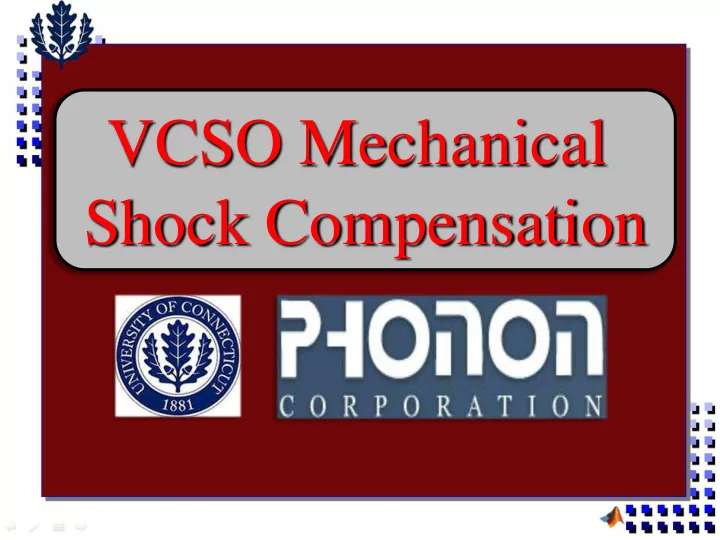

VCSO Mechanical Shock Compensation
Who are we? Team members: Max Madore Joseph Hiltz-Maher Shaun Hew Shalin Shah Advisor: Helena Silva Phonon contact: Scott Kraft
Project Overview • VCSO and mechanical vibration • Analog filter for compensation of 20dB • Expand compensation to three axes
Starting Point • Build off of Previous Project Results: – Shock Tower for creating and testing – Similar test setup and simulations • How we can improve: – We have more accurate testing tools – Seeking more repeatable results – Achieve compensation in 3 axis (X, Y, Z)
Current Research • VCSO – Voltage Controlled SAW Oscillator • SAW – Surface Acoustic Wave and the resonator embedded in the VCSO • Accelerometer- Mounted to the VCSO to work in conjunction • Different Filter topologies
Necessary Knowledge • Phase Noise – time domain jitter • Effect of shock on the overall system – Especially the VCSO • Effects of incorporating filters for compensation
Why Capacitive Accelerometer Advantages • Dissipate minimal power. • Large Bandwidth. • Less prone to noise • High accuracy and stability
Capacitive Accelerometer • Detect a change in electrical capacitance with vibration. • Output of the circuit is change as a result . • Capacitors alter peak voltage by oscillator under vibration. • Detection circuit capture peak voltage. • Summing amplifier processes final output.
How Will Compensation Be Achieved? Accelerometer Shock Filter Output VCSO
Testing Setup Shock Accelerometer Filter VCSO Signal Phase Frequency Generator Detector Filter DAQ PC
Our Setup
Our Setup
The Shock Tower
VSCO & Accelerometer • Extremely high impedance control input acts as antenna • Can throw off results especially when solenoid fired
Phase Frequency Detector • Output of VCSO too high for PFD • Will be adding an attenuator
Data Acquisition Card
Constructed Circuits
Circuit Designs Switching Circuit • Timing control via DAQ • Darlington array of 2N3055 power BJTs for current requirements Subtraction Circuit • LM308 operational amplifier • Subtracts two outputs from phase frequency detector to view full signal
Darlington Circuit
Differential Amplifiers • Tested multiple op-amps • Unity Gain Issue
Circuit Designs Low Pass Filter Circuit • Output of mixer creates high frequency noise • Interested only up to 2kHz phase noise • Designed to match specifications Compensation Circuit • Fully analog, fits casing • Test 0 th , 1 st , 2 nd order compensation • Provide at least 20dB compensation
Compensation Circuit • 2 Resistor Voltage Divider • Further calculations necessary to find ideal ratio
MATLAB Code Written • Currently implemented: • Collects data from the phase frequency detector • Fires shock tower solenoid for a specified pulse length • Plots the collected data • To be implemented: • Phase unwrapping • Data smoothing • Instantaneous frequency calculations • Data analysis
Current Results Phase frequency detector output of uncompensated shock response
Current Results Phase frequency detector and accelerometer output with and without compensation Once we have repeatable 0 th order compensation we can look for evidence of frequency dependence and other issues
Goals • Acquire data from accelerometer in single axis. • Construct a zero-th order filter for single axis compensation. • Expand testing to 3 axis using multiple axis accelerometer (Mems or Capacitive) • Explore higher order filters if necessary. • Expand loop filter for 3 axis compensation . • Simulate final circuit in case upgrades are required.
Timeline
Budget Given Materials: • National Instruments X series USB-6353 Data Acquisition Card • NI-DAQmx software • MATLAB 2009 • Giga-tronics 6060B Signal Generator • Phonon 400MHz VCSOs • B&K 9130 triple output power supply • Phase Frequency Detectors • Shock Tower Materials to Purchase: • Accelerometers $250 • Analog Filter Circuit Components $50 • Vibration Damping Supplies $50 • Phase Frequency Detectors $150 Total Estimated Cost: $500
Questions?
Recommend
More recommend